2013 SUZUKI ERTIGA belt
[x] Cancel search: beltPage 42 of 207
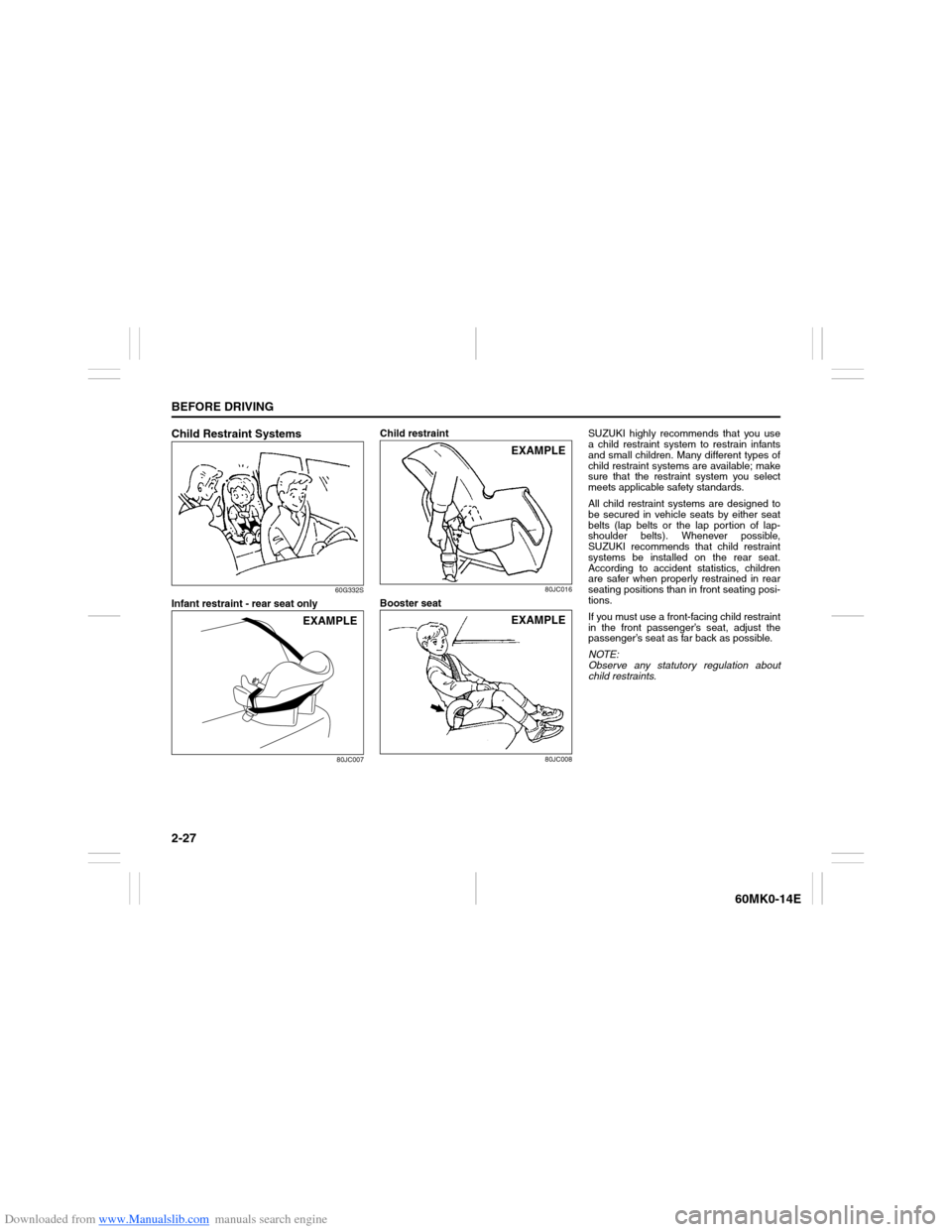
Downloaded from www.Manualslib.com manuals search engine 2-27BEFORE DRIVING
60MK0-14E
Child Restraint Systems
60G332S
Infant restraint - rear seat only
80JC007
Child restraint
80JC016
Booster seat
80JC008
SUZUKI highly recommends that you use
a child restraint system to restrain infants
and small children. Many different types of
child restraint systems are available; make
sure that the restraint system you select
meets applicable safety standards.
All child restraint systems are designed to
be secured in vehicle seats by either seat
belts (lap belts or the lap portion of lap-
shoulder belts). Whenever possible,
SUZUKI recommends that child restraint
systems be installed on the rear seat.
According to accident statistics, children
are safer when properly restrained in rear
seating positions than in front seating posi-
tions.
If you must use a front-facing child restraint
in the front passenger’s seat, adjust the
passenger’s seat as far back as possible.
NOTE:
Observe any statutory regulation about
child restraints.
EXAMPLE
EXAMPLEEXAMPLE
Page 44 of 207
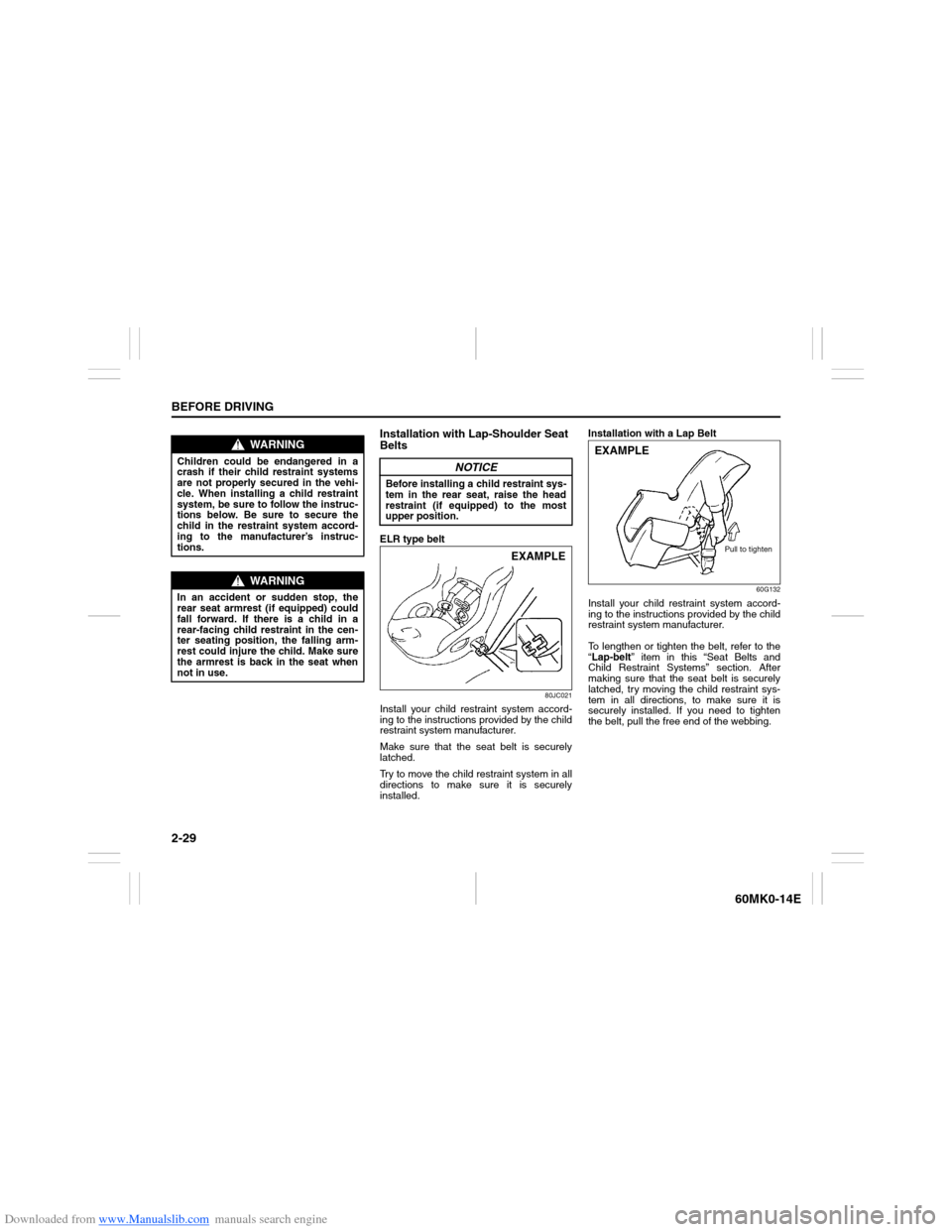
Downloaded from www.Manualslib.com manuals search engine 2-29BEFORE DRIVING
60MK0-14E
Installation with Lap-Shoulder Seat
BeltsELR type belt
80JC021
Install your child restraint system accord-
ing to the instructions provided by the child
restraint system manufacturer.
Make sure that the seat belt is securely
latched.
Try to move the child restraint system in all
directions to make sure it is securely
installed.Installation with a Lap Belt
60G132
Install your child restraint system accord-
ing to the instructions provided by the child
restraint system manufacturer.
To lengthen or tighten the belt, refer to the
“Lap-belt” item in this “Seat Belts and
Child Restraint Systems” section. After
making sure that the seat belt is securely
latched, try moving the child restraint sys-
tem in all directions, to make sure it is
securely installed. If you need to tighten
the belt, pull the free end of the webbing.
WARNING
Children could be endangered in a
crash if their child restraint systems
are not properly secured in the vehi-
cle. When installing a child restraint
system, be sure to follow the instruc-
tions below. Be sure to secure the
child in the restraint system accord-
ing to the manufacturer’s instruc-
tions.
WARNING
In an accident or sudden stop, the
rear seat armrest (if equipped) could
fall forward. If there is a child in a
rear-facing child restraint in the cen-
ter seating position, the falling arm-
rest could injure the child. Make sure
the armrest is back in the seat when
not in use.
NOTICE
Before installing a child restraint sys-
tem in the rear seat, raise the head
restraint (if equipped) to the most
upper position.
EXAMPLE
EXAMPLE
Pull to tighten
Page 45 of 207

Downloaded from www.Manualslib.com manuals search engine 2-30
BEFORE DRIVING
60MK0-14E
Supplemental Restraint
System (air bags)
(if equipped)Your vehicle is equipped with a Supple-
mental Restraint System consisting of the
following components in addition to a lap-
shoulder belt at each front seating position.
1. Driver’s front air bag module
(if equipped)
2. Front passenger’s front air bag mod-
ule (if equipped)
3. Air bag controller (if equipped)
4. Forward crash sensor (if equipped)
WARNING
This section of the owner’s manual
describes the protection provided by
your SUZUKI’s SUPPLEMENTAL
RESTRAINT SYSTEM (air bags).
Please read and follow ALL these
instructions carefully to minimize
your risk of severe injury or death in
the event of a collision.
60MK017
EXAMPLE
1
2
3
4
Page 46 of 207
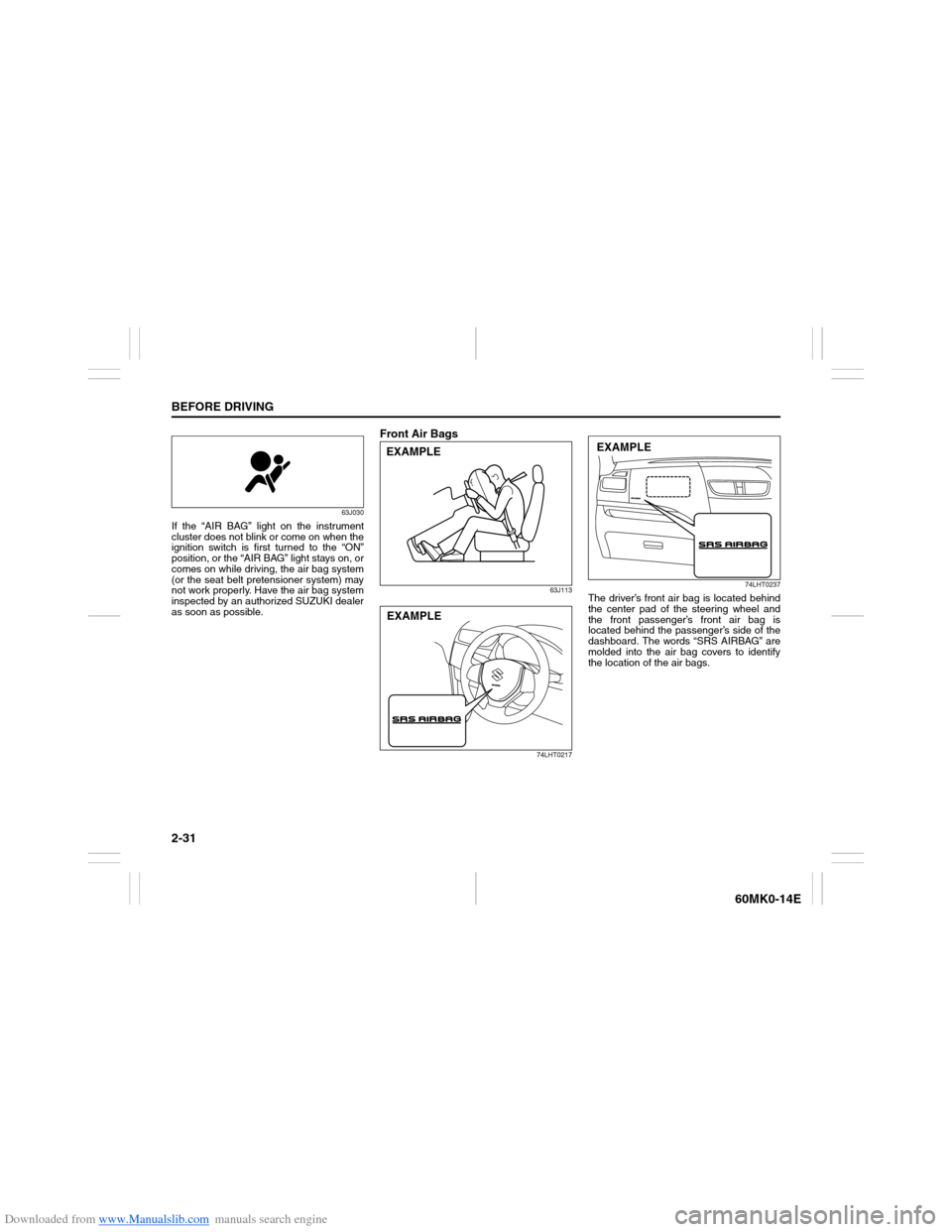
Downloaded from www.Manualslib.com manuals search engine 2-31BEFORE DRIVING
60MK0-14E
63J030
If the “AIR BAG” light on the instrument
cluster does not blink or come on when the
ignition switch is first turned to the “ON”
position, or the “AIR BAG” light stays on, or
comes on while driving, the air bag system
(or the seat belt pretensioner system) may
not work properly. Have the air bag system
inspected by an authorized SUZUKI dealer
as soon as possible.
Front Air Bags
63J113
74LHT021774LHT0237
The driver’s front air bag is located behind
the center pad of the steering wheel and
the front passenger’s front air bag is
located behind the passenger’s side of the
dashboard. The words “SRS AIRBAG” are
molded into the air bag covers to identify
the location of the air bags.
EXAMPLEEXAMPLE
EXAMPLE
Page 47 of 207
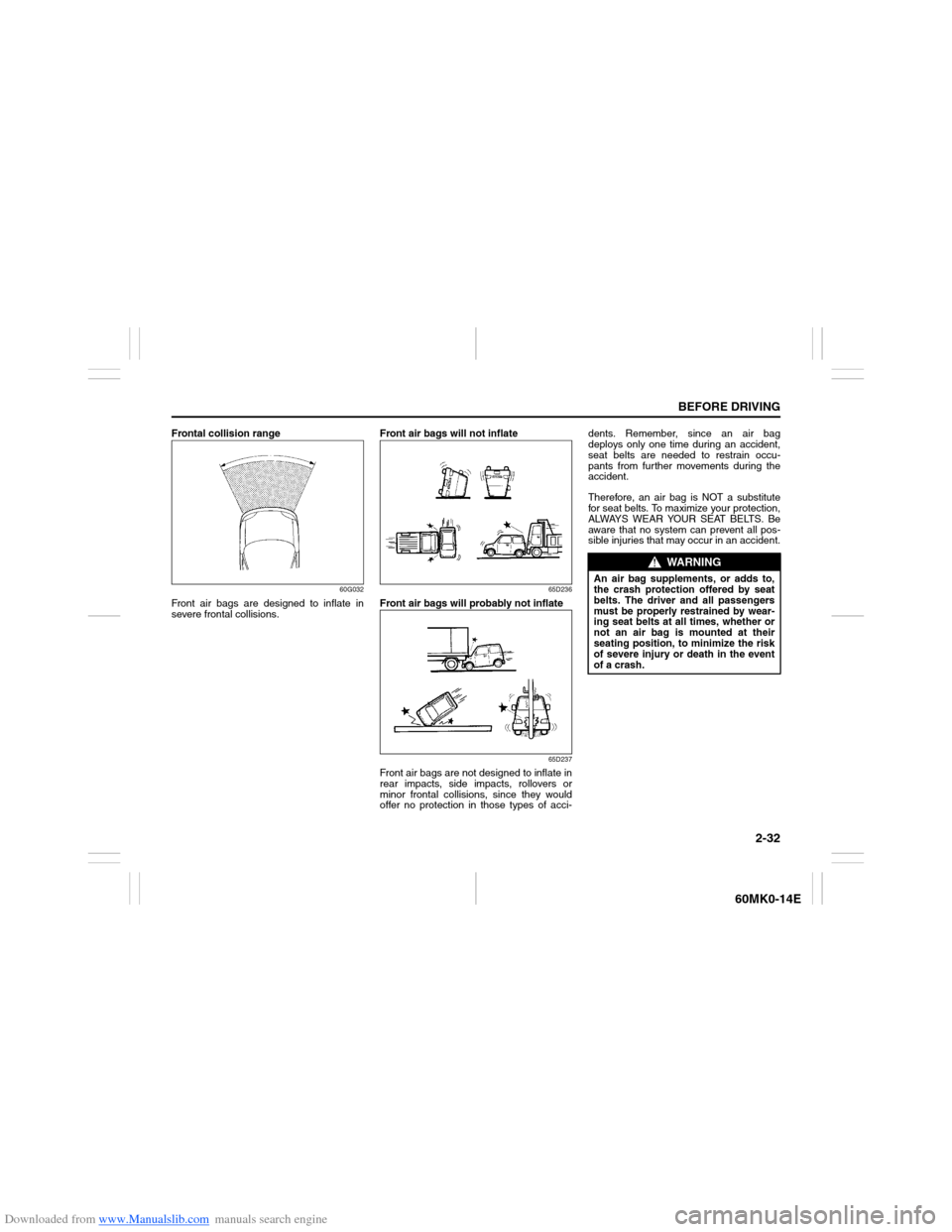
Downloaded from www.Manualslib.com manuals search engine 2-32
BEFORE DRIVING
60MK0-14E
Frontal collision range
60G032
Front air bags are designed to inflate in
severe frontal collisions.Front air bags will not inflate
65D236
Front air bags will probably not inflate
65D237
Front air bags are not designed to inflate in
rear impacts, side impacts, rollovers or
minor frontal collisions, since they would
offer no protection in those types of acci-dents. Remember, since an air bag
deploys only one time during an accident,
seat belts are needed to restrain occu-
pants from further movements during the
accident.
Therefore, an air bag is NOT a substitute
for seat belts. To maximize your protection,
ALWAYS WEAR YOUR SEAT BELTS. Be
aware that no system can prevent all pos-
sible injuries that may occur in an accident.
WARNING
An air bag supplements, or adds to,
the crash protection offered by seat
belts. The driver and all passengers
must be properly restrained by wear-
ing seat belts at all times, whether or
not an air bag is mounted at their
seating position, to minimize the risk
of severe injury or death in the event
of a crash.
Page 48 of 207
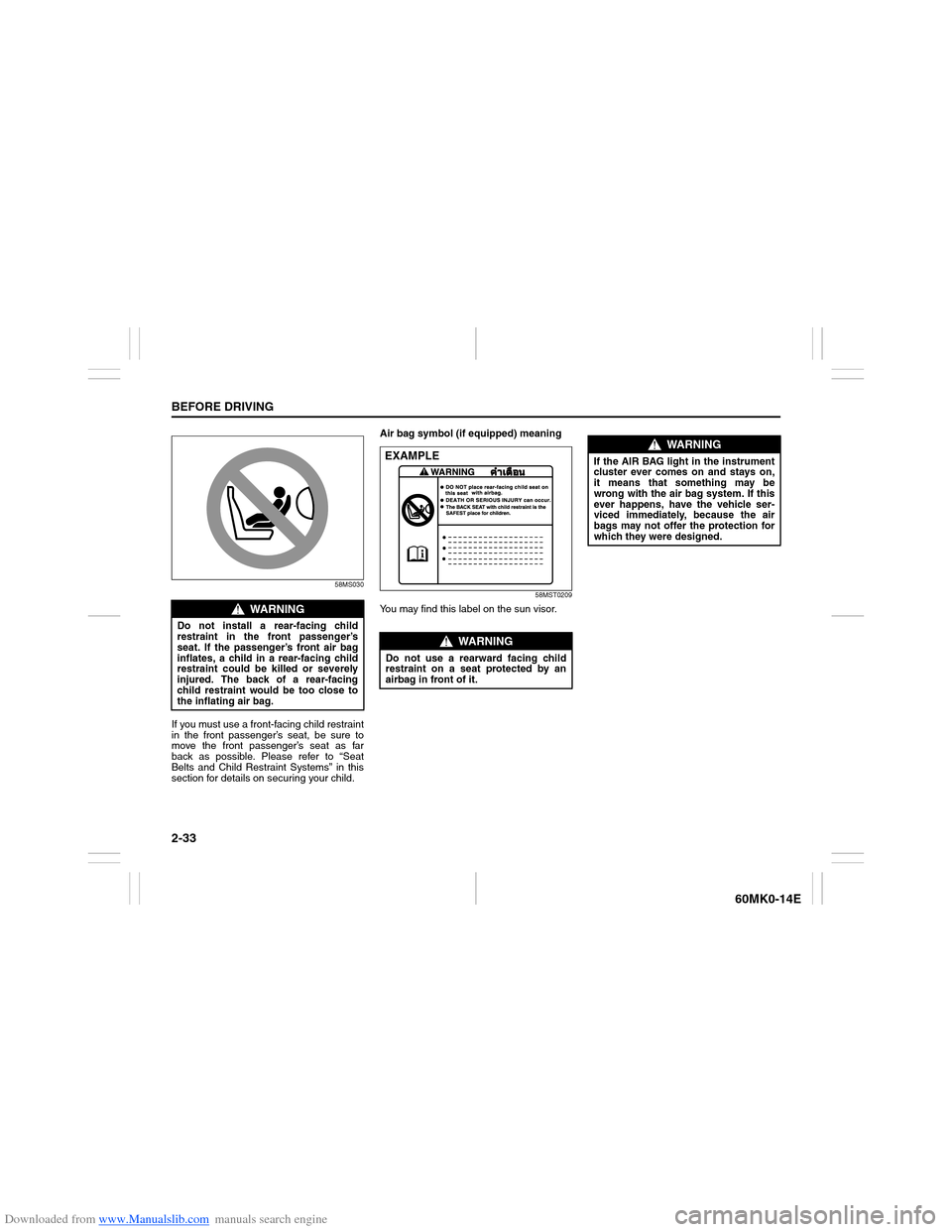
Downloaded from www.Manualslib.com manuals search engine 2-33BEFORE DRIVING
60MK0-14E
58MS030
If you must use a front-facing child restraint
in the front passenger’s seat, be sure to
move the front passenger’s seat as far
back as possible. Please refer to “Seat
Belts and Child Restraint Systems” in this
section for details on securing your child.Air bag symbol (if equipped) meaning
58MST0209
You may find this label on the sun visor.
WARNING
Do not install a rear-facing child
restraint in the front passenger’s
seat. If the passenger’s front air bag
inflates, a child in a rear-facing child
restraint could be killed or severely
injured. The back of a rear-facing
child restraint would be too close to
the inflating air bag.
WARNING
Do not use a rearward facing child
restraint on a seat protected by an
airbag in front of it.EXAMPLE
WARNING
If the AIR BAG light in the instrument
cluster ever comes on and stays on,
it means that something may be
wrong with the air bag system. If this
ever happens, have the vehicle ser-
viced immediately, because the air
bags may not offer the protection for
which they were designed.
Page 49 of 207

Downloaded from www.Manualslib.com manuals search engine 2-34
BEFORE DRIVING
60MK0-14E
How the System WorksIn a frontal collision, the crash sensors will
detect rapid deceleration, and if the con-
troller judges that the deceleration repre-
sents a severe frontal crash, the controller
will trigger the inflators. The inflators inflate
the appropriate air bags with nitrogen or
argon gas. The inflated air bags provide a
cushion for your head and upper body. The
air bag inflates and deflates so quickly that
you may not even realize that it has acti-
vated. The air bag will neither hinder your
view nor make it harder to exit the vehicle.
Air bags must inflate quickly and forcefully
in order to reduce the chance of serious or
fatal injuries. However, an unavoidable
consequence of the quick inflation is that
the air bag may irritate bare skin, such as
the facial area against a front air bag. Also,
upon inflation, a loud noise will occur and
some powder and smoke will be released.
These conditions are not harmful and do
not indicate a fire in the vehicle. Be aware,
however, that some air bag components
may be hot for a while after inflation.A seat belt helps keep you in the proper
position for maximum protection when an
air bag inflates. Adjust your seat as far
back as possible while still maintaining
control of the vehicle. Sit fully back in your
seat; sit up straight; do not lean over the
steering wheel or dashboard. Please refer
to the “Seat Adjustment” section and the
“Seat Belts and Child Restraint Systems”
in this section for details on proper seat
and seat belt adjustments.
65D610
WARNING
The driver should not lean over the
steering wheel. The front passen-
ger should not rest his or her body
against the dashboard, or other-
wise get too close to the dash-
board. In these situations, the out-
of-position occupant would be too
close to an inflating air bag, and
may suffer severe injury.
Do not attach any objects to, or
place any objects over, the steering
wheel or dashboard. Do not place
any objects between the air bag
and the driver or front passenger.
These objects may interfere with air
bag operation or may be propelled
by the air bag in the event of a
crash. Either of these conditions
may cause severe injury.
Page 55 of 207

Downloaded from www.Manualslib.com manuals search engine 2-40
BEFORE DRIVING
60MK0-14E
Charging Light
50G052
This light comes on when the ignition
switch is turned to the “ON” position, and
goes out when the engine is started. The
light will come on and remain on if there is
something wrong with the battery charging
system. If the light comes on when the
engine is running, the charging system
should be inspected immediately by your
SUZUKI dealer.Driver’s Seat Belt Reminder Light
60G049
If the driver’s seat belt is unbuckled when
the ignition switch is turned to the “ON”
position, this light will blink until the driver’s
seat belt is buckled.
For details about the seat belt reminder,
refer to “Seat Belts and Child Restraint
Systems” in this section.
“AIR BAG” Light (if equipped)
63J030
This light blinks or comes on for several
seconds when the ignition switch is turned
to the “ON” position so you can check if the
light is working.
The light will come on and stay on if there
is a problem in the air bag system or the
seat belt pretensioner system (if
equipped).
Malfunction Indicator Light
65D530
Your vehicle has a computer-controlled
emission control system. A malfunction
indicator light is provided on the instrument
panel to indicate when it is necessary to
have the emission control system serviced.
The malfunction indicator light comes on
when the ignition switch is turned to the
“ON” position to let you know the light is
working and goes out when the engine is
started.
If the malfunction indicator light comes on
or blinks when the engine is running, there
is a damage in the emission control sys-
tem.
Bring the vehicle to your SUZUKI dealer to
have the damage fixed.
Also, if this light comes on when the engine
is running, there is the problem with the
automatic transaxle system. Ask your
SUZUKI dealer to have the system
inspected.
WARNING
If the “AIR BAG” light does not blink
or come on briefly when the ignition
switch is turned to the “ON” position,
stays on for more than 10 seconds,
or comes on while driving, the air bag
system or the seat belt pretensioner
system (if equipped) may not work
properly. Have both systems
inspected by an authorized SUZUKI
dealer.